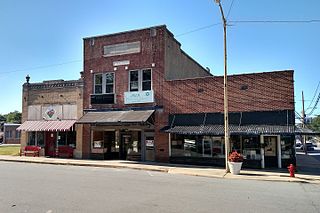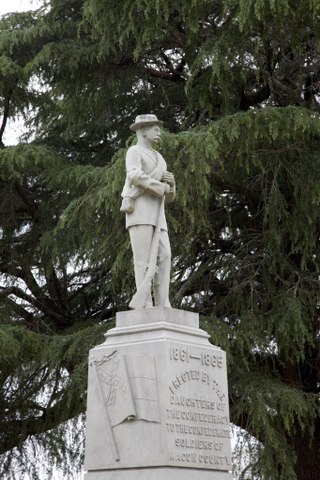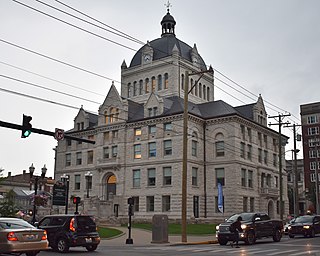
The Main Street Historic District in Danbury, Connecticut, United States, is the oldest section of that city, at its geographical center. It has long been the city's commercial core and downtown. Its 132 buildings, 97 of which are considered contributing properties, include government buildings, churches, commercial establishments and residences, all in a variety of architectural styles from the late 18th century to the early 20th. It is the only major industrial downtown of its size in Connecticut not to have developed around either port facilities or a water power site.

The Monument Park Historic District is a historic district centered on Monument Park in downtown Fitchburg, Massachusetts. The district has one of the city's finest assemblages of high-quality architecture, including a number of civic, religious, and commercial buildings near the park. The district was listed on the National Register of Historic Places in 1978.

The Confederate Soldier Monument in Caldwell County, Kentucky is a historic statue located on the Caldwell County Courthouse south lawn in the county seat of Princeton, Kentucky, United States. It was erected in 1912 by the Tom Johnson Chapter No. 886 of the United Daughters of the Confederacy (UDC).

The Warsaw Courthouse Square Historic District is a historic district in Warsaw, Indiana that was listed on the National Register of Historic Places in 1982. Its boundaries were increased in 1993.

The Genesee County Courthouse Historic District is located at the junction of Main, West Main and Ellicott streets in downtown Batavia, New York, United States. It is a small area with the county courthouse, a war memorial and other government buildings dating from the 1840s to the 1920s. Some were originally built for private purposes.

The Shelby County Courthouse in Harlan, Iowa, United States, was built in 1892. It was individually listed on the National Register of Historic Places in 1978 as a part of the County Courthouses in Iowa Thematic Resource. In 1994 it was included as a contributing property in the Harlan Courthouse Square Commercial District. The courthouse is the third building the county has used for court functions and county administration.

The historic Cabarrus County Courthouse in Concord, North Carolina was completed in 1876, replacing one that was destroyed by fire just the previous year. It was designed by architect G.S.H. Appleget. It includes Second Empire, Italianate, Classical Revival, and other architecture. It was listed on the National Register of Historic Places in 1974. In 1975, a new courthouse was built; the historic courthouse is now the home of the Cabarrus County Veterans Museum and the Cabarrus Arts Council. It is located in the South Union Street Courthouse and Commercial Historic District.

The Downtown Brandon Historic District is a ten-acre district consisting of the downtown square of Brandon, Mississippi, United States, mainly located along a section of East and West Government Street. The district also includes the 100th block of North College Street, where St. Luke's Episcopal Church and the Purvis House are located; as well as the 100th block of Black Street, where a historic African American Theater is located. The district was added to the National Register of Historic Places in 2010. The district includes two other places listed on the NRHP: the Rankin County Confederate Monument and the Rankin County Courthouse.
The current Burke County Courthouse is located at 201 South Green Street, Morganton, Burke County, North Carolina and operates as the courthouse for Burke County. It was opened in 1976 to replace the Old Burke County Courthouse. The old courthouse, in use by 1837, is listed on the National Register of Historic Places.

The Marianna Commercial Historic District encompasses the historic civic and commercial heart of Marianna, Arkansas, the county seat of Lee County. It comprises two blocks of Main Street and two blocks of Poplar Street, which cross at the northwest corner of Court Square, a city park where the Gen. Robert E. Lee Monument is found, and extends south to include a few buildings on Liberty Street.

The Lonoke Downtown Historic District encompasses a portion of the central business district of Lonoke, Arkansas. It extends south along Center Street, from the Lonoke County Courthouse to Front Street, and then one block east and west on both sides of Front Street. It extends eastward on the south side of Front Street another 1-1/2 blocks. Lonoke was founded as a railroad community in 1862, and this area represents the core of its downtown area for the period 1900–1945. Most of the district's 23 buildings are commercial structures, one to two stories in height, with brick facades.

The Tuskegee Confederate Monument, also known as the Macon County Confederate Memorial and Tuskegee Confederate Memorial, is an outdoor Confederate memorial in Tuskegee, Alabama, in the United States. It was erected in 1906 by the United Daughters of the Confederacy to commemorate the Confederate soldiers from Macon County, Alabama.

The Cadiz Downtown Historic District, in Cadiz, Kentucky, is a historic district which was listed on the National Register of Historic Places in 1988. It includes Main Street from Scott Street to Franklin Street. It included 16 contributing buildings.

The Scottsville Downtown Commercial Historic District, in Scottsville, Kentucky is a 14 acres (5.7 ha) historic district which was listed on the National Register of Historic Places in 2001.

The Davenport Downtown Commercial Historic District is a nationally recognized historic district located in the central business district of Davenport, Iowa, United States. It was listed on the National Register of Historic Places in 2020. At the time of its nomination it consisted of 43 resources, which included 33 contributing buildings, one contributing structure, and nine non-contributing buildings. In addition, the district also contains 33 buildings that are individually listed on the National Register. This historic district is bordered by four other districts: the Crescent Warehouse Historic District and the Davenport Motor Row and Industrial Historic District on the east, the Hamburg Historic District to the northwest, and the West Third Street Historic District on the west.

The Main Street Historic District comprises the commercial and governmental core of Tuskegee, Alabama. The historic district includes more than one hundred contributing structures along a ten-block by three-block stretch of North and South Main Street.

The Old Fayette County Courthouse (Kentucky) is a mixed-use commercial and civic office building located at 215 West Main Street in downtown Lexington, Kentucky, USA. It was originally built in 1898–1900 and designed by Cleveland-based architects Lehman & Schmitt, the fifth structure to be used as the Fayette County Courthouse. The building now contains civic offices, event spaces, and commercial retail space. It has been called the "most iconic building in Lexington."






















